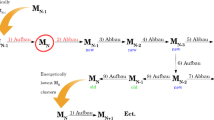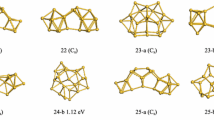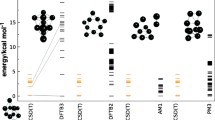Abstract
Based on the work of previous researchers, a new unbiased optimization algorithm—the dynamic lattice searching method with two-phase local search and interior operation (DLS-TPIO) —is proposed in this paper. This algorithm is applied to the optimization of Lennard-Jones (LJ) clusters with N = 2–650, 660, and 665–680. For each case, the putative global minimum reported in the Cambridge Cluster Database (CCD) is successfully found. Furthermore, for LJ533 and LJ536, the potential energies obtained in this study are superior to the previous best results. In DLS-TPIO, a combination of the interior operation, two-phase local search method and dynamic lattice searching method is adopted. At the initial stage of the optimization, the interior operation reduces the energy of the cluster, and gradually makes the configuration ordered by moving some surface atoms with high potential energy to the interior of the cluster. Meanwhile, the two-phase local search method guides the search to the more promising region of the configuration space. In this way the success rate of the algorithm is significantly increased. At the final stage of the optimization, in order to decrease energy of the cluster further, the positions of surface atoms are further optimized by using the dynamic lattice searching method. In addition, a simple new method to identify the central atom of icosahedral configurations is also presented. DLS-TPIO has higher computing speed and success rates than some well-known unbiased optimization methods in the literature.
Similar content being viewed by others
References
Doye JPK. Physical perspectives on the global optimization of atomic clusters. In: Pinter J D, eds. Global Optimization: Scientific and Engineering Case Studies. Berlin: Springer-Verlag, 2006. 103–139
Cheng LJ, Feng Y, Yang J, Yang JL. Funnel hopping: Searching the cluster potential energy surface over the funnels. J Chem Phys, 2009, 130: 214112
Fa W, Luo CF, Dong JM. Bulk fragment and tubelike structures of AuN (N = 2–26). Phys Rev B, 2005, 72: 205428
Wales DJ, Doye JPK. Global optimization by basin-hopping and the lowest energy structures of Lennard-Jones clusters containing up to 110 atoms. J Phys Chem A, 1997, 101: 5111–5116
Wales DJ, Scheraga HA. Global optimization of clusters, crystals and biomolecules. Science, 1999, 285: 1368–1372
Leary RH. Global optimization on funneling landscapes. J Global Optim, 2000, 18: 367–383
Leary RH. Tetrahedral global minimum for the 98-atom Lennard-Jones cluster. Phys Rev E, 1999, 60: R6320–R6322
Xue GL. Molecular conformation on the CM-5 by parallel two-level simulated annealing. J Global Optim, 1994, 4: 187–208
Wille LT. Simulated annealing and the topology of the potential energy surface of Lennard-Jones clusters. Comput Mater Sci, 2000, 17: 551–554
Krivov SV. Hierarchical global optimization of quasiseparable systems: Application to Lennard-Jones clusters. Phys Rev E, 2002, 66: 025701
Deaven DM, Tit N, Morris JR. Structure optimization of Lennard-Jones clusters by a genetic algorithm. Chem Phys Lett, 1996, 256: 195–200
Wolf MD, Landman U. Genetic algorithms for structural cluster optimization. J Phys Chem A, 1998, 102: 6129–6137
Hartke B. Global cluster geometry optimization by a phenotype algorithm with niches: Location of elusive minima, and lower-order scaling with cluster size. J Comput Chem, 1999, 20: 1752–1759
Romero D, Barron C, Gomez S. The optimal geometry of Lennard-Jones clusters: 148–309. Comput Phys Commun, 1999, 123: 87–96
Xiang YH, Jiang HY, Cai WS, Shao XG. An efficient method based on lattice construction and the genetic algorithm for optimization of large Lennard-Jones clusters. J Phys Chem A, 2004, 108: 3586–3592
Lee J, Lee I, Lee J. Unbiased global optimization of Lennard-Jones clusters for N ⩽ 201 using the conformational space annealing method. Phys Rev Lett, 2003, 91: 080201
Cheng LJ, Cai WS, Shao XG. A connectivity table for cluster similarity checking in the evolutionary optimization method. Chem Phys Lett, 2004, 389: 309–314
Jiang HY, Cai WS, Shao XG. A random tunneling algorithm for the structural optimization problem. Phys Chem Chem Phys, 2002, 4: 4782–4788
Takeuchi H. Clever and efficient method for searching optimal geometries of Lennard-Jones clusters. J Chem Inf Model, 2006, 46: 2066–2070
Shao XG, Cheng LJ, Cai WS. A dynamic lattice searching method for fast optimization of Lennard-Jones clusters. J Comput Chem, 2004, 25: 1693–1698
Yang XL, Cai WS, Shao XG. A dynamic lattice searching method with constructed core for optimization of Lennard-Jones clusters. J Comput Chem, 2007, 28: 1427–2433
Shao XG, Yang XL, Cai WS. A dynamic lattice searching method with interior operation for unbiased optimization of large Lennard-Jones clusters. J Comput Chem, 2008, 29: 1772–1779
Wu X, Cai WS, Shao XG. A dynamic lattice searching method with rotation operation for optimization of large clusters. Chem Phys, 2009, 363: 72–77
Cheng LJ, Cai WS, Shao XG. An energy-based perturbation and a taboo strategy for improving the searching ability of stochastic structural optimization methods. Chem Phys Lett, 2005, 404: 182–186
Pullan W. An unbiased population-based search for the geometry optimization of Lennard-Jones Clusters: 2 ⩽ N ⩽ 372. J Comput Chem, 2005, 26: 899–906
Cai WS, Shao XG. A fast annealing evolutionary algorithm for global optimization. J Comput Chem, 2002, 23: 427–435
Northby JA. Structure and binding of Lennard-Jones clusters: 13 ⩽ N ⩽ 147. J Chem Phys, 1987, 87: 6166–6177
Xiang YH, Cheng LJ, Cai WS, Shao XG. Structural distribution of Lennard-Jones clusters containing 562 to 1000 atoms. J Phys Chem A, 2004, 108: 9516–9520
Shao XG, Xiang YH, Cai WS. Structural transition from icosahedra to decahedra of Lennard-Jones clusters. J Phys Chem A, 2005, 109: 5193–5197
Locatelli M, Schoen F. Efficient algorithms for large scale global optimization: Lennard-Jones clusters. Comput Optim Appl, 2003, 26: 173–190
Doye JPK, Leary RH, Locatelli M, Schoen F. The global optimization of Morse clusters by potential energy transformations. INFORMS J Comput, 2004, 16: 371–379
Cassioli A, Locatelli M, Schoen F. Global optimization of binary Lennard-Jones clusters. Optim Method Softw, 2009, 24: 819–835
Cheng LJ, Yang JL. Global minimum structures of Morse clusters as a function of range of the potential: 81 ⩽ N ⩽ 160. J Phys Chem A, 2007, 111: 5287–5293
Cheng LJ, Cai WS, Shao XG. Geometry optimization and conformational analysis of (C60)N clusters by using a dynamic lattice searching method. ChemPhysChem, 2005, 6: 261–266
Zhan H, Cheng LJ, Cai WS, Shao XG. Structural optimization of silver clusters from Ag61 to Ag120 by dynamic lattice searching method. Chem Phys Lett, 2006, 422: 358–362
Shao XG, Xiang YH, Cai WS. Formation of central vacancy in icosahedral Lennard-Jones clusters. Chem Phys, 2004, 305: 69–75
Liu HH, Jiang EY, Bai HL, Wu P, Li ZQ. Impact of atomic shells on the structure of clusters. Chem Phys Lett, 2005, 412: 195–199
Liu DC, Nocedal J. On the limited memory BFGS method for large scale optimization. Math Program, 1989, 45: 503–528
Doye JPK. The effect of compression on the global optimization of atomic clusters. Phys Rev E, 2000, 62: 8753–8761
Author information
Authors and Affiliations
Corresponding author
Rights and permissions
About this article
Cite this article
Lai, X., Xu, R. & Huang, W. Prediction of the lowest energy configuration for Lennard-Jones clusters. Sci. China Chem. 54, 985–991 (2011). https://doi.org/10.1007/s11426-011-4280-4
Received:
Accepted:
Published:
Issue Date:
DOI: https://doi.org/10.1007/s11426-011-4280-4




